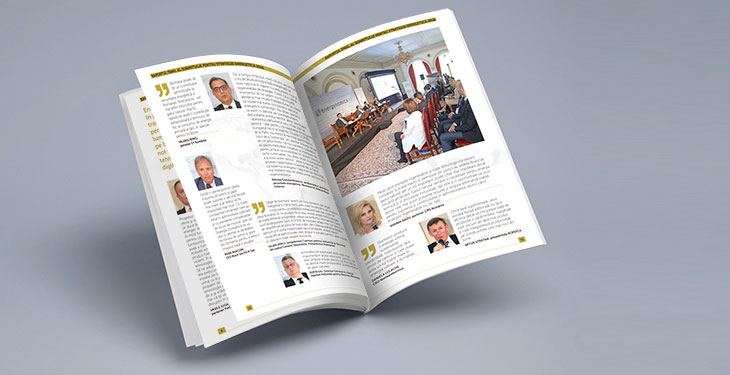New technologies and new market realities force the global energy industry into redesigning its business models, in all significant areas. Romania is part of this dramatic change and it is the central authorities’ well-acknowledged duty to provide the companies and the customers with the guiding lines of its future energy landscape. Romania has the chance to benefit from the latest technological advances in order to upgrade its energy infrastructure, so that it become not only an essential engine for the local economy and society, but also a relevant supplier of energy security in the region.
Building on its important and diversified natural resources, as well as on its strong educational infrastructure and on its geographical location, Romania should aim at developing as a reliable transit node in the European energy grids, by strengthening its production, storage, and transportation capabilities. This report examines economic, political and strategic considerations related to the future of the Romanian energy system, as they resulted from the debates during the 2016 Energy Strategy Summit. New technologies are the key for reinventing the energy generation – be it from fossil fuels (oil, gas, or coal), be it from renewable resources (wind, solar, or biomass) -, for improved energy storage and power transmission. For attracting these new technologies a stable and predictable fiscal frame is required. The 2016 Energy Strategy Summit key findings are outlined below.
Energy is in the process of transformation for a green world, based on a new technological and digital revolution
Globally, there is a huge effort invested by states, companies and academia in reinventing the energy for a sustainable future in a green world. A world where new forms of energy are no longer polluting, but clean, no longer expensive, but cheap, and readily available for all. This comes as the greatest of challenges for all existing businesses in energy.
At the same time, technological developments have already modified the long-term stable landscape of the industry. New technologies brought to market new resources (such as shale, offshore deep, renewables), and dramatically reduced the energy demand, decoupling it from economic growth. The technological impact forces the companies to do more than what traditional business model encouraged them to.
For Romania, this is an opportunity to reconnect to the poles of technological development, to stop the brain drain, and to make use of many natural resources inaccessible untill now. To start with, the right incentive schemes are necessary to bring these cutting-edge technologies into the local market, to attract the money and stimulate visionary approaches.
All types of energy resources are necessary for a proper resilient and sustainable energy sector in Romania
Blessed with a balanced energy mix, Romania has access to all the natural resources for granting its energy industry a resilient and sustainable future. Already, its hydro generated power is the backbone for the electricity production, while the nuclear produces cheap, sustainable, predictable, clean, carbon-free energy. With all the technological advances, fossil fuels are still needed for the decades to come. It is the case for natural gas, a cleaner solution among the others, and it is the case for oil, as the sole option for transportation in the near decades. But it is also the case for coal, a resource Romania depends upon whenever it is going through extreme temperatures, and a resilience provider in times of need.
This being said, the decarbonization is the target to follow, and renewable sources are the answer for the future. It depends on how fast the technology matures (on generation, storage and transmission of power) and on how flexible the market design will evolve to increase the share of a self-sustainable renewable sector in the total energy mix.
However, firstly, an efficient management of people, equipment and installations must be ensured in each of the companies, in the state-owned companies in particular. Then, functional and predictable markets are needed for each and all of these primary resources to find their way to the consumer, locally and abroad.
Interconnectivity, which is physical interconnections, as well as connected markets, is the guarantee for energy security and continuity of supply
Interconnectivity is the answer for both security of supply and well-functioning internal markets. On the one hand, Romania should capitalize on its geographical location and on the new found EU’s awareness of the fact that its political and social security are based on more energy interconnectors and transit routes at its Eastern border. It is the high time for the countries in CEE Europe, together with the Baltic countries, to work together on energy issues. And it is the high time for all concerned to understand that investing in energy security is investing in national security. It is a chance materialized in significant amount of money already assigned for projects of common interest at European level. It is also a challenge for the local companies, such as Transgaz (BRUA project, Black Sea project, Moldova project), Conpet (for liquid energy transportation), and Transelectrica to prove their project management capabilities, as well as for the Romania as a state, to make sure that all trading inside and outside the borders is regulated properly.
On the other hand, it is the distributed generation that, on the consumer level, guarantees both energy security and continuity of supply. Technologies labeled as Smart have as a common factor connectivity and shared infrastructure. Still, for the moment, the theoretical idea based on the energy independence perspective cannot be implemented because of the existing legislation, lack of initiative or lack of courage. Integrating the small, local energy producers is opening the way for a more stable national power grid, and also for new business opportunities at the meeting points of power generation, trading, supply and distribution, with IT, telecom and energy efficiency services.
A formalized inter-institutional cooperation between the legislative, the executive and the regulators is required for a more adaptable energy sector in Romania
While fundamentally compliant with the EU legislative and regulatory framework, Romania is still undergoing a massive modernization and upgrading of its primary and secondary legislation related to the energy industry. There are essential laws under the scrutiny of the Parliament (such as the Energy Law, the Petroleum Law, the Renewables and Biomass Laws). Although the methodology and practice of public debates with all shareholders improved a lot, there are many important changes blocked for months or for years. This is the single most important impediment for new investments to be implemented (e.g. in the Oil and Gas Upstream sector, onshore and offshore), and it puts under threat numerous finished projects (e.g. in the Renewables sector). Besides, many other changes in legislation are expected with upcoming reviews on EU energy package.
The regulatory bodies are prevented from action, e.g. the deadline for the long awaited NAMR Round XI for the concession of new petroleum exploration blocks depends on the approval of the new fiscal regime for hydrocarbons, or overwhelmed by regulations needed to be put in place, e.g. NARE has issued almost one thousand Orders in recent years, and another one thousand Orders and Decisions are in the line for the next years!
Many of the private financed initiatives in energy – as they are capital intensive and longtime projects – depend on legislation and regulations in place, which is true not only for existing businesses, but more so for new businesses, based on new, more expensive and more riskier technologies (e.g. deep water exploration, battery storage, or rooftop photovoltaic equipment.) That is why an inter-institutional cooperation between the legislative, the executive and the regulators should be granted for shortening the time between the moment when a specific legislative or regulatory change is identified as necesary, and the moment when it is enforced.
————————-
Organized by energynomics.ro, the 2016 Energy Strategy Summit brought together over 120 participants and was attended by 23 leading representatives of the companies and the authorities in the energy industry.


